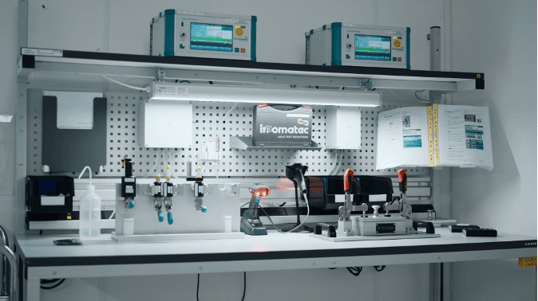innomatec recently worked with Inreda Diabetic B.V., a manufacturer of drug delivery pumps based in the Netherlands. Their flagship product, the Inreda AP® (artificial pancreas) device, is transforming the way people with diabetes live their lives.
Inreda turned to innomatec to help them design an accurate, reliable leak test process for a one-drug delivery pump in preparation for the development of a leak test process for their upcoming AP®6 bi-hormonal model—a new product poised to help reduce the burden of managing type 1 diabetes for patients.
Medical assemblies such as drug delivery pumps can be quite a complex design. Complex designs, especially those with intricate and controlled inner workings, often require multi-step leak test processes. Each phase of assembly that has the potential to create new leaks needs to be leak tested to ensure the product quality of the finished device.
GET ALL THE DETAILS IN THE APPLICATION NOTE →
4 Factors to Consider in Your Leak Test Design of a Complex Medical Assembly
Using innomatec’s approach to Inreda’s leak test design process as an example, we can illustrate the different considerations for manufacturers when designing a leak test for a complex medical assembly.
1. Fixturing requirements to maintain control and accuracy
In this case, to ensure reliable product quality in the field, each step of drug delivery pump assembly needed to be leak tested, requiring a complex and controlled, multi-step leak test process. The process was designed to keep the test process as fast and efficient as possible while maintaining the utmost leak measurement accuracy.
To do this, manufacturers must correctly isolate and control the component being tested at each stage to ensure accurate results. Seals, fixtures, and chambers were used to ensure adequate control over environmental factors like temperature, humidity, barometric pressure, and more.
2. Automated vs. manual assembly requirements
Whether the leak test will be automated or manual (or a mix of both) is a decision based on a variety of factors, including desired cycle time, desired output, budget, available staff, and more. In this case the test was to be manually operated, using the capabilities of innomatec’s LTC leak test computers to streamline the process.

How it worked: Operators scan the barcoded test part, then place the part onto a quick connector. They then flip a lever and select the appropriate program number for their test. This approach allows for a flexible, compact design, using only one test chamber—a cost-effective, efficient design to serve their needs.
This approach and process was designed to ensure accurate, consistent test results, with special adjustments can be made to make the leak test procedures as operator-friendly as possible, and minimizing the potential for any operator-induced error—which is especially important when designing manual leak tests for complex assemblies.
3. Scalability requirements
Scalability allows for a manufacturer to accommodate future needs—which in this case, were anticipated. Scalability on a manual testing bench can refer to accommodating a faster test process, more operators at one bench, adding more benches, or the ability to easily add automated assembly processes to speed the testing process further and maximize yield.
For Inreda, the test bench was designed for manual testing to start, but the ability to accommodate automations later, without too much re-work.
Part of being able to scale is also about the capabilities of the instrumentation used in your leak test bench design. The robustness and flexibility of innomatec’s LTC leak test platform made it possible to achieve this complex and precise test solution using standard instrumentation.
4. Product design refinement opportunities
As this project with Inreda was to design a leak test for a one-drug delivery pump in preparation for the development of a leak test process for their new upcoming AP®6 bi-hormonal model, this offered a unique opportunity for the team to look at the product design itself and how the new model could be made with the highest leak-tightness possible.
In this way, leak test specialists and manufacturers can collaborate to develop a new process and standard for the development of parts and assemblies into the future.
 “It wasn’t just a matter of testing to see if the product was leak tight or not. Of course, that's important, but innomatec also helped us learn more about how the design of the product could help improve leak tightness,” said Mr. Olaf van Straaten, COO, Inreda.
“It wasn’t just a matter of testing to see if the product was leak tight or not. Of course, that's important, but innomatec also helped us learn more about how the design of the product could help improve leak tightness,” said Mr. Olaf van Straaten, COO, Inreda.
The Inreda AP®6 bi-hormonal model is projected to be available to the public in Q3 2026. With their new scalable leak test solution, Inreda will be able to easily scale their manufactured volume as they expand to serve diabetes patients worldwide.
READ THE APPLICATION NOTE FOR MORE DETAILS ON THE TEST PROCESS →
Contact innomatec to help design your leak test
innomatec’s expert knowledge, attention to detail, and persistent pursuit of excellence led to a very fruitful collaboration with Inreda. innomatec has over 40 years’ experience working with leading manufacturers across the globe, helping them design accurate, repeatable leak tests and solve leak test challenges on their manufacturing lines to ensure production efficiency and the highest product quality.
Contact us to help you design an effective, efficient, and operator-friendly leak test procedure.





